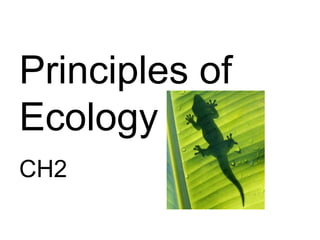
Principles of Ecology: Organisms, Energy Flow & Matter Cycling
- 2. 2.1 Organisms and Their Relationships Ecology: Study of interactions between organisms and the living (biotic) and nonliving (abiotic) components of their environment. Biotic Factors: in a pond, fish, algae, frogs, insects, turtles, plants Abiotic Factors: Temperature, air/water currents, sunlight, soil type, precipitation, nutrient availability.
- 3. LEVELS OF ORGANIZATION: Population: All the interbreeding members of a species in a community. Community: All the species of organisms in an ecosystem. Ecosystems: Community of organisms and non-living components in a particular place. Ex: pond, coral reef, mountain, desert Biome: Group of ecosystems with similar climates & communities. Biosphere: Contains all life
- 5. ECOLOGY OF ORGANISMS: Habitat: Where an organism lives Niche: An organism’s role or way of life in the environment. Fundamental: Where & how organism could live Realized: Where & how it actually lives in the face of competition. Generalist: Broad niche, very adaptable; Coyote, Hawk, rat. Specialist: Very narrow niche; very limited. Koala Abiotic factors change,and organisms that are adapted to certain conditions may only survive where the environment suits them.
- 6. A fundamental niche overlap results in two species using the same resources; those organisms within the overlap compete against their own & the other species; they are eliminated, the species move apart, resulting in character displacement. COMPETITION
- 7. Resource partitioning in a tree. Species use different parts; this allows greater numbers of individuals in each species, and reduces the competition between species.
- 8. COMPETITION If more than one species uses the same resource at the same time. More efficient species may outcompete others.
- 9. Balanus removed: Chthamalus moves down; Chthalamus removed, Balanus remained as it was; not adapted to life in very dry areas.
- 10. COMPETITION: Competitive exclusion: In using a resource, more efficient species eliminates others from the community.
- 11. PREDATION Natural selection favors predators with adaptations that increase their efficiency in finding, capturing, and killing prey. Rattlesnakes have heat sensing pits, sharks sense electrical impulses from victim’s muscles. Both initiate hunt with excellent sense of smell. Natural selection favors adaptations in prey that help it escape predators.
- 12. In ecology, affecting one element of an ecosystem will affect all other components, living & non-living. In Yellowstone, reintroduction of the wolf reduced the number of deer in the park. Birch trees grew along streams again, plants & animals associated with Birch returned to the park. Reintroduction of 1 species (wolf) resulted in restoring proper ecologic balance to ecosystem, and the reappearance of 200 associated species.
- 14. Torpedo Ray- captures food by electrocuting it between its fins. Glow worms attract prey with light, capture with silky, sticky threads.
- 15. SYMBIOSIS: Organisms that are related ecologically. PARASITISM: Predator lives on/in prey, weakens it. MUTUALISM: 2 spp. Interact, help each other. COMMENSALISM: One benefits, other unaware.
- 16. 2.2 Flow of Energy in an Ecosystem PRODUCERS Autotrophs: Make own food. Support whole ecosystems by making organic molecules from inorganic ones. Photosynthesizers: Plants, algae, bacteria. Use sunlight, CO2 , and H2O to make sugars. Chemosynthesizers: Bacteria. Use inorganic molecules to make sugars. On land, plants are major producers. In aquatic environments, algae and bacteria are major producers.
- 17. CONSUMERS Heterotrophs: Need to eat other organisms, or organic wastes. All animals, most protists, all fungi, many bacteria. Herbivores: Eat plants; primary consumers. Carnivores: Eat other consumers. Secondary consumers Omnivores: Eat producers and consumers. Detritivores: consumers that eat dead organisms, or their wastes. Decomposers: Decay organic matter by breaking down molecules; release nutrients into the ecosystems.
- 18. PRODUCTIVITY: Net Primary Productivity: Rate at which biomass accumulates in a system. Biomass: The organic material in an ecosystem contained in living organisms. .
- 21. ENERGY FLOW Trophic Level: An organism’s position in the sequence of energy transfers. Energy is lost in transfer from one level to the next.
- 22. FOOD WEB Feeding relationships in an ecosystem; made up of several overlapping food chains.
- 23. Pyramid of Biomass showing the relative amounts of producers and consumers in an ecosystem.
- 24. 2.3 Cycling of Matter ECOSYSTEM RECYCLING Biogeochemical Cycles: Substances moving from abiotic portions of the environment, into living organisms, and back again. Water, Carbon, Oxygen, Nitrogen, and Phosphorus cycles.
- 25. Water Cycle: Water availability is a key factor regulating ecosystem productivity. Evaporation: Adds water vapor to atmosphere. Transpiration: Water released from ground through plants. Precipitation: Water in atmosphere condenses, and falls back to earth.
- 27. Carbon Cycle Photosynthesizers use CO2 and water from environment and sunlight to form sugars. Sugars are stored in plants, algae, bacteria, and are passed on as producers are eaten. Sugars are broken down in producers and consumers, usually with oxygen, to form CO2 and water.
- 29. Oxygen is released into the atmosphere by photosynthesis as sugars are made, and it is removed by respiration, as sugars are broken down.
- 30. Nitrogen Cycle Nitrogen is needed by all organisms to make DNA, RNA, and proteins. Nitrogen gas is removed from the atmosphere (78% N2 ) by nitrogen-fixing bacteria, which live in soil and in the roots of some plants. These bacteria convert N2 gas to ammonia, which is then distributed throughout the ecosystem by plant consumption & death. Nitrifying bacteria convert ammonia to nitrates, which plants use to grow. Denitrifying bacteria release the nitrogen back into the atmosphere,